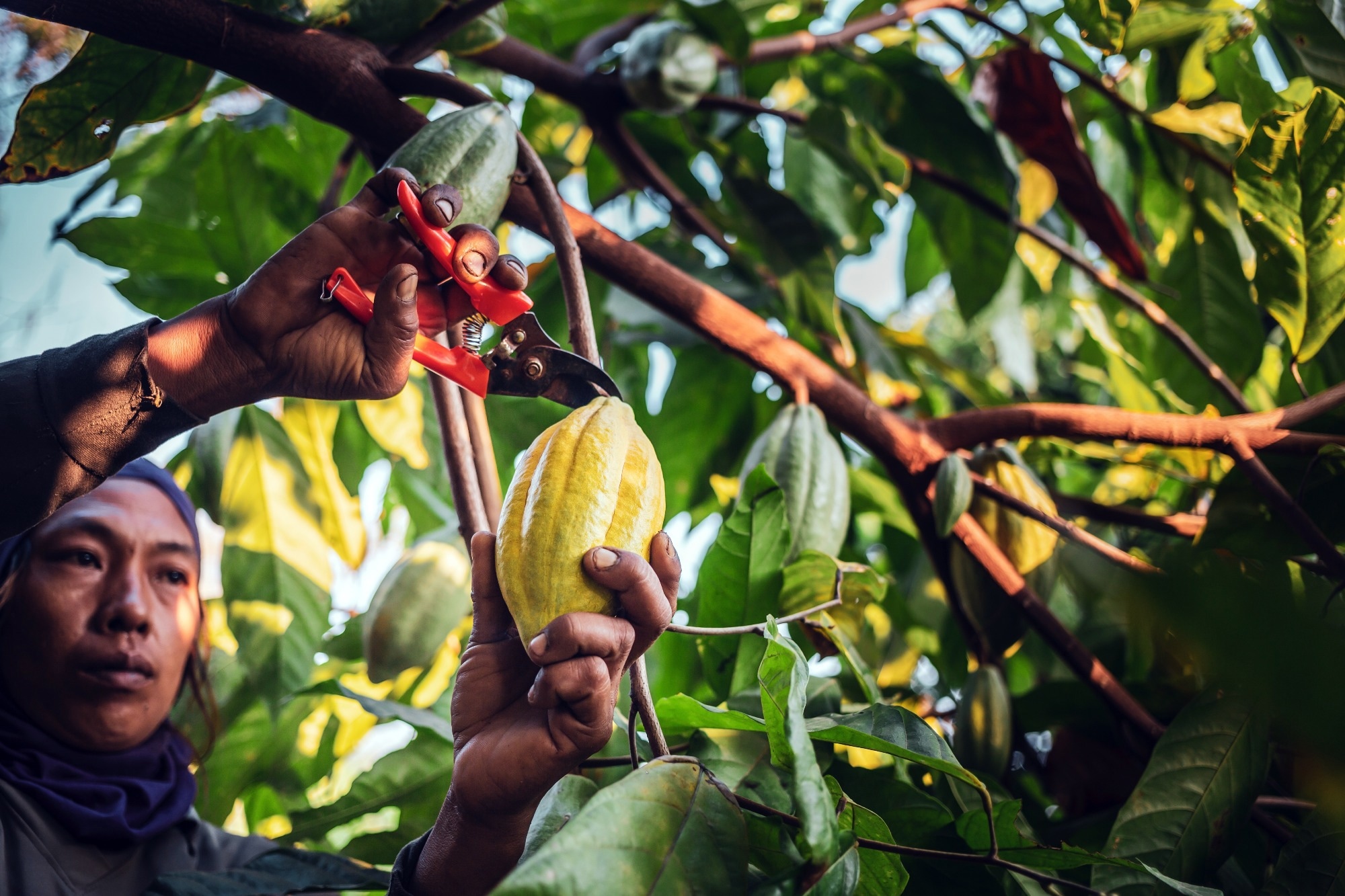 By Pooja Toshniwal PahariaReviewed by Lauren HardakerAug 27 2025
By Pooja Toshniwal PahariaReviewed by Lauren HardakerAug 27 2025In a recent study published in Nature Microbiology, researchers investigated microbial interactions and fermentation conditions that shape the flavor of cocoa beans. They found that microbial activity and fermentation conditions (temperature and pH) jointly shape the flavor profiles of fine chocolates.
 Study: A defined microbial community reproduces attributes of fine flavour chocolate fermentation. Image credit: Narong Khueankaew/Shutterstock.com
Study: A defined microbial community reproduces attributes of fine flavour chocolate fermentation. Image credit: Narong Khueankaew/Shutterstock.com
Using a defined microbial consortium, they demonstrated the potential for controlled fermentations to produce high-quality, premium chocolate.
Cocoa bean fermentation is a spontaneous process in which abiotic and microbial interactions generate metabolites that shape chocolate flavor and aroma. Unlike wine, cheese, or beer, cocoa bean fermentation relies on naturally assembling microbial communities, resulting in variability across regions and influencing flavor quality. Understanding these microbial dynamics is crucial to reproducing desired flavor profiles and developing controlled fermentation strategies, paving the way for a more standardized, industry-level process in chocolate production.
About The Study
In the present study, researchers investigated whether a defined microbial consortium and abiotic markers could reproduce fine flavor attributes reliably.
The researchers conducted field experiments across three tropical agroecological zones in Colombia (Santander, Antioquia, and Huila) in May (mid-season) and October–November (primary harvesting season). Single-nucleotide polymorphism (SNP) genotyping confirmed genetic similarities among the cocoa varieties.
The team performed on-farm fermentations using traditional wooden boxes, monitoring temperature, pH (pulp/testa and cotyledon), and bean color daily. They collected environmental samples (soil, leaves, pods, box surfaces, worker hands, and fruit flies) alongside fermenting beans, yielding 70 samples for whole-metagenomic shotgun sequencing analysis.
Metagenome-assembled genomes (MAGs) assessed microbial community dynamics based on microbial taxonomic and metabolic traits. The analysis utilized Theobroma cacao and Homo sapiens reference genomes. The Shannon diversity index assessed alpha diversity, whereas Bray-Curtis dissimilarity matrices revealed beta diversity.
After isolating, sequencing, and characterizing bacterial and fungal strains for metabolic potential, the researchers prepared a defined microbial consortium, which was then tested in controlled microbox fermentations using sterilized cocoa beans and artificial pulp. Experiments, including full consortia, dropout assays, and random consortia, evaluated the reproducibility of fermentation outcomes.
The team produced cocoa liquor from the fermented beans to assess the flavor. A trained sensory panel evaluated flavor profiles, following Cocoa of Excellence recommendations. For benchmarking, reference liquors included those from the Ivory Coast/Ghana (bulk chocolates) and Madagascar (fine chocolates). Gas chromatography-mass spectrometry (GC-MS) analyzed volatile organic compounds (VOCs), and liquid chromatography-mass spectrometry (LC-MS) assessed non-volatile metabolites to link microbial and abiotic markers to flavor outcomes.
Importantly, the study also applied predictive modelling (random forest and generalized linear models) to link fermentation kinetics and microbial markers to sensory attributes, showing that temperature and pH kinetics were especially strong predictors of fine flavor notes and could reliably forecast outcomes.
To further validate the findings, the researchers analyzed 19 additional natural fermentations carried out in Trinidad between 2018 and 2022. These served as an independent dataset confirming that the abiotic and microbial markers identified in Colombia also predict fine-flavor traits across diverse agroecological groups.
Results
The team found that flavor notes of fine chocolates are associated with specific fermentation kinetics. These include time to maximum pH, point of temperature inflection, and cotyledon pH changes. Genome-resolved metagenomics revealed redundant metabolic traits in the microbial community. The traits are essential for flavor development, confirming that microbial activity drives the chemical transformations underlying the observed shifts in pH and temperature.
Bean temperatures demonstrated a sigmoidal increase after 24 hours, consistent with the exothermic nature of microbial metabolism. In contrast, pH exhibited compartmentalized changes: the pulp/testa pH dropped below 4.0 within 48 hours before increasing linearly, whereas cotyledon pH decreased sigmoidally and was inversely correlated with bean temperature. The changes in temperature and pH aligned with changes in bean color, supporting their use as reliable fermentation indicators.
Microbial diversity shifted dynamically over time. Bacterial communities transitioned from Erwiniaceae dominance (with depleted Pectobacteriaceae and Enterobacteriaceae) in the initial 24 hours to an enrichment of Acetobacteraceae after 48 hours. Fungal communities demonstrated progressive Saccharomycetaceae abundance (with diminished Debaryomycetaceae and Nectriaceae).
Declines in alpha diversity reflected substrate-driven selective pressures. Beta diversity changes showed temporal and geographic signals, especially in fungal populations. Specific taxa, particularly Saccharomyces and Torulaspora, strongly predicted fine flavor attributes, including floral, caramel, and woody notes. The findings indicate that pH and temperature influence coordinated interkingdom interactions.
Defined microbial communities reproduced natural fermentation dynamics, including characteristic pH kinetics and VOC profiles. Beans fermented with the defined consortium yielded cocoa liquors with flavor notes similar to premium chocolates from Madagascar, Santander, and Huila. In contrast, liquor from Antioquia consistently resembled bulk chocolates from the Ivory Coast and Ghana. The study also noted that bacterial inoculation often originates from fermentation box surfaces, acting as a “memory”. At the same time, fungi are introduced from diverse environmental sources, helping to explain geographical differences in fermentation outcomes.
Sensory evaluations by trained panels confirmed that controlled fermentations using specific microbial starters reliably reproduce the flavor characteristics of fine chocolates.
Conclusions
The study findings demonstrate that metabolic traits essential for cocoa fermentation are redundantly distributed within microbial communities and can accumulate in a defined consortium capable of reproducing the flavor of fine chocolates under controlled conditions. The findings highlight the feasibility of designing microbial starters that bring consistency and control to cocoa fermentation, reducing reliance on unpredictable spontaneous processes.
Validated across diverse regions and harvests, and further confirmed with independent data from Trinidad, this approach paves the way for a contemporary chocolate industry, similar to beer and cheese production, where controlled fermentations reliably yield high-quality, fine-flavor chocolate.
Download your PDF copy now!
Journal Reference
Gopaulchan, D., Moore, C., Ali, N., et al. (2025). A defined microbial community reproduces attributes of fine-flavor chocolate fermentation. Nat Microbiol., DOI: 10.1038/s41564-025-02077-6 https://www.nature.com/articles/s41564-025-02077-6